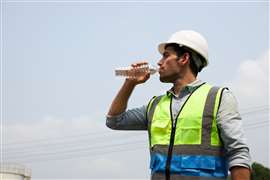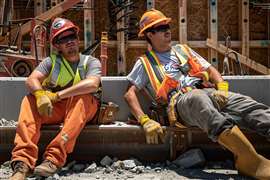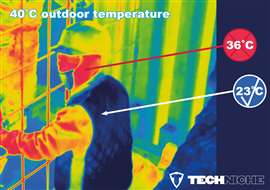Four tips to protect your construction crew from heat illness
25 June 2024
From India to southern Europe to Saudi Arabia and the US, countries across the northern hemisphere are breaking longstanding heat records this spring with higher temperatures still to come in summer.
In late May, India recorded a high more than 50 degrees Celsius (122 Fahrenheit), and a labourer died with reports suggesting heat stroke as a cause. During the summer there, around 60% of construction workers experience mild to severe heat-related symptoms, according to a recent survey.
In Europe, where countries including Greece, the Balkans and Turkey are sweltering in an ongoing heatwave, heat-related workplace fatalities are reported to have risen 42% since 2000.
 Workers drink water as they take a break at a construction site on a hot summer day in New Delhi, India, May 20, 2024. Photo: Reuters/Priyanshu Singh
Workers drink water as they take a break at a construction site on a hot summer day in New Delhi, India, May 20, 2024. Photo: Reuters/Priyanshu Singh
And in the most populated region of the US – the Northeast, which includes the cities of Boston, New York, Philadelphia, and Washington D.C. – a massive heat dome settled in just days before summer, and temperatures are expected to break above 100-degrees Fahrenheit (38-degrees Celsius) for days on end.
Rising temps a trend
The danger that excessive heat poses to construction workers looks set to rise.
A study published in the scientific journal Communications Earth & Environment’s (CEE) warned that by 2050, people living in subtropic and tropic regions will endure as many as 182 days of dangerous heat. By 2100, even midlatitude regions with temperate climates are projected to have as many as 90 days annually in the danger zone.
With the temperatures and stakes high, the world’s contractors are employing multiple strategies to keep their workers hydrated, shaded, and safe.
Here’s a look at some of the simple methods:
1) Create easy access to water, encourage consumption
Contractors should make every effort to ensure drinkable water is on-site and provide time to consume it, and encourage consumption, regardless of what laws do or do not exist.
“It doesn’t really have to be that hot to affect [a] person,” said Texas, US-based Dr Ricky McShane during an Associated General Contractors of America webinar on heat illness, who noted dehydration is one of the most common afflictions for workers. “Everybody gets…different susceptibilities to different things.”
Access to water breaks was a hot topic last year in Texas, US, after the state government passed a controversial bill (House Bill 2127) that was signed into law by the governor.
The law, at the time, was promoted as a necessary deregulation of Texan industry, as it sought to restrict or limit local municipalities’ ability to adopt or enforce local ordinances that exceeded state law.
 OSHA is seeking submissions for a new campaign aimed at combatting heat-related work problems. (Photo: Adobe Stock)
OSHA is seeking submissions for a new campaign aimed at combatting heat-related work problems. (Photo: Adobe Stock)
Opponents, however, noted the new law nullified city ordinances passed in Dallas and Austin, which guaranteed a 10-minute water break every four hours for workers.
A Texas judge found the law unconstitutional, but the state is appealing that ruling.
A similar bill in Florida, US, passed the state legislation in May but is not yet law.
At present, the US’ Occupational Safety and Health Administration (OSHA), a regulatory agency of the US Department of Labor, does not have a federal standard for providing access to water. The agency recently began steps in creating a standard, however, the process takes years.
Dr McShane said good practice is for contractors to build their own protocols and not view hydration as a distraction or hinderance but an aid.
“We want companies to have a plan. We don’t want you to ignore it,” he said, noting the benefits of a hydrated workforce include better focus and endurance, and the consequences can be deadly. “Dehydration causes the muscles to not physiologically work anymore.”
Building in breaks and urging water consumption (and discouraging beverages like energy drinks and coffee), Dr McShane said, can help offset workers who might regularly show up to work dehydrated without knowing it.
“They were dehydrated yesterday, [then] they went home, maybe drank some alcohol at night, they got up in the morning, drank coffee, but they keep getting further and further behind the eightball,” he added. “Then they go into this work environment with the high heat exertion, and they just don’t have the ability to tolerate the dehydration.”
Dr McShane noted medications, genetics, and pre-existing conditions will also alter each workers’ individual tolerance for high-heat environments, which means ‘more is more’ as it pertains to water and available time to drink it.
He noted, anecdotally, that stereotypes of the younger workforce being able to ‘handle’ the heat should be ignored, as well. In his experience, younger workers end up more susceptible to dehydration and heat-related illness.
2) Monitor weather and breaks and provide shady, cool spaces
Offering outdoor workers, at minimum, a shady place to take breaks is also highly encouraged, though separate facilities (even a vehicle equipped with air conditioning) can go a long way in preventing heat-related illness.
 Construction workers take a shade break (Image: Generated with AI by Davivd via AdobeStock - stock.adobe.com)
Construction workers take a shade break (Image: Generated with AI by Davivd via AdobeStock - stock.adobe.com)
Indoor worksites should not be overlooked, either. Many countries are now regulating how hot indoor workplaces can be. Germany and Spain set maximums of 26- and 25-degrees Celsius (79- and 77-degrees), respectively.
Germany also added measures that require adequate ventilation for indoor work, reduction of hours, and the provision of drinks during extreme heat events or environments (more than 35-degrees Celsius [95-degrees Fahrenheit]).
In Cyprus, employers are required by a published code of practice to monitor weather and take applicable measures to reduce heat stress, including reducing work intensity.
While there is a professional and personal boundary between employer and employees during break and lunch time, Dr McShane noted that even light observation of how a crew spends its off-time could reveal dangerous (even if unintended) consequences.
He recalled a worker who, eager to lose weight, was jogging in a black athletic suit during his splits.
“You would think that wouldn’t be a smart thing to do, but all he knew is he needed to lose weight, [and] nobody paid attention that he was out jogging,” he said. “I think it comes down to knowing your employees a little bit.”
3) Adapt work hours during extreme heat events
Not all heat is created equal. Especially in Qatar, one of the hottest countries in the world, where the decade-long infrastructure construction for the 2022 World Cup was problematic.
Qatar officials estimated 400-500 labourers died while contributing to the project, though some reports have suggested the number is higher. Officials did not say how many deaths were heat related.
The yearslong process, though, prompted wholesale changes to the Qatar construction industry, including adjustments to handling the heat.
The country adopted a new solution for the region, which it implemented during the World Cup build in 2017: They banned construction during the hottest parts of summer, which was extended during the run-up to the World Cup. No one was permitted to work outside from 1 June to 15 September between the hours of 10 a.m. and 3:30 p.m.
Other Middle Eastern countries and China have adopted similar measures. India’s National Disaster Management Authority has advised avoiding strenuous work between 12pm and 3pm.
4) Explore novel solutions
 Illustration of a TechNiche cooling vest (Image: TechNiche)
Illustration of a TechNiche cooling vest (Image: TechNiche)
The Qatar World Cup project also got creative with new personal protective equipment (PPE), as modern products were not suitable or designed to combat Middle Eastern heat.
UK-based cooling PPE company TechNiche developed cooling vests that reduce the wearer’s body temperature by up to 15C. The Supreme Committee for Delivery & Legacy (SC) in charge of the World Cup there issued thousands of the vests to workers.
Meanwhile, some construction companies are testing out wearable sensors that monitor biometric data in a bid to reduce heat-related injuries and deaths.
Last year, Rogers-O’Brien Construction piloted a programme to test sensors on a site at Southern Methodist University in Dallas, Texas. The sensors, connected to software called SafeGuard, measure heart rate, body temperature and other indicates and if it they detect worrying readings over a period of time then they notify a safety supervisor.
STAY CONNECTED



Receive the information you need when you need it through our world-leading magazines, newsletters and daily briefings.
CONNECT WITH THE TEAM








